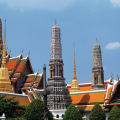GRAND PALAIS & WAT PHRA KAEO
The Grand Palace complex was built in 1782 and includes not only the throne room and royal halls, but also a number of government offices and the famous Temple of the Emerald Buddha (Wat Phra Kaeo). Of Western inspiration, only a part of the palace can be visited. The royal family now resides in the north of Bangkok in the Chitralada Palace, the Grand Palace receives only some royal ceremonies. The Chakri Maha Prasat, a modern royal residence, was built during the reign of King Chulalongkorn, from 1877 to 1882, by the English architect MR. John Clunish, which explains its European style. One can visit the throne room Amari Vinichai where the king always makes his birthday speech as well as the small museum of weapons in particular. Just next door is the Wat Phra Kaeo whose construction was completed in 1784, two years after the capital was moved from Thonburi to Rattanakosin. The complex was constantly enriched by the various successive kings. The temple which occupies the North-East of the Grand Palace is probably one of the most sacred sanctuaries of Thailand.
The Emerald Buddha
. It is to him that Wat Phra Kaeo owes its fame. The most venerated statue in Thailand, the famous Emerald Buddha, has an origin difficult to trace. It is admitted that it was found in a temple of Chiang Rai, about 1431. It was then covered with gold leaf. Later, the stucco under the gold leaf crumbled, and the green stone appeared. It was then claimed to be an emerald (actually jasper) statue and was immediately considered sacred.The governor of Chiang Rai spoke to the king of Chiang Mai, who wanted to obtain it. Elephants were sent to bring it back, but on their way back they headed towards Lampang instead of Chiang Mai. The king saw this as a divine omen and allowed the city to keep the statue. In 1468, the new king of Chiang Mai brought the statue to his capital. One of his successors left in 1552 to fight the rebels in Luang Prabang and took the Emerald Buddha with him. He later settled in Vientiane and kept it there. In 1778, King Rama I, then a general, took Vientiane and brought the Emerald Buddha back to Thonburi. After his ascension to the throne, he built Wat Pra Kaeo, whose ubosot now houses the famous statue. The Emerald Buddha is 76 cm high and 45 cm wide. It rests on a golden pedestal at the top of a golden altar of 11 m and under a 9-storey parasol. He changes his clothes according to the seasons: in summer, he wears an enamelled golden tunic, decorated with precious stones; during the rainy season, a bronze toga enamelled with blue; in winter, it is a golden mesh robe that covers him from head to foot.
The visit
. In the axis of the entrance door, a marble platform serves as a base for Prasat Phra Thep Bidon, the Royal Pantheon. The life-size statues of the eight kings are kept there. The pantheon is only open one day a year, on April 6, the day of the commemoration of the Chakri dynasty. Behind it is the library, Phra Mondop, built in 1787, where a beautiful mother-of-pearl cabinet contains the sacred manuscripts. The floor is covered with silver mats. On the right, there is a miniature reproduction of Angkor Wat. Finally, in the four corners, there are four Buddha statues, in Javanese style, from the 14th and 15th centuries.Behind the library stands the golden spire of the great chedi
, or stupa, Phra Si Rattana, which was built by King Rama IV in 1855, and is covered with gold ceramics imported from Italy. Relics of Buddha are kept inside, hence the respect due to these places. The frescos of the cloister tell the Ramakien, the Thai version of the Ramayana, the great Hindu epic.One will notice that this temple is very well guarded by Yakças of 6 m high, armed with a sword, with the face of various colors. Everywhere also, Kinnaris and Nagas.
One temple is a replica of Angkor Wat, built so that the king's subjects could appreciate Khmer architecture. The Phra Asadha Maha Chedi consists of eight prang
lined up on the eastern side, clad in faience and mosaics, are dedicated to the Buddhist Trinity: the Buddha, the Law and the Community of monks, as well as to some disciples whose ashes are kept there. The Hor Phra Gandhararat, erected by Rama IV, shelters a statue of Buddha venerated by the farmers for its power to bring rain.The belfry, covered with a mosaic of coloured porcelain, still sounds on special occasions.
Finally, the Phra Maha Montian is a group of 7 buildings. In 2013, a new museum is born, that of the textiles of Queen Sirikit. A journey through time with the dresses of the queen from the 1960s to today.
The site of the royal cremation. It is now in the enclosure of the Grand Palace that the ashes of Rama IX are located. The construction of the royal cremation site cost about 25 million euros. Many craftsmen were requisitioned during one year to offer the most beautiful of the possible burials to the late king. This site is open to the public, but strict rules must be observed in order to visit it.
Did you know? This review was written by our professional authors.
Members' reviews on GRAND PALAIS & WAT PHRA KAEO
The ratings and reviews below reflect the subjective opinions of members and not the opinion of The Little Witty.














Attention, les jambes doivent être entièrement couvertes (pour hommes et femmes).
Les monuments sont vraiment éblouissants...
A ne pas rater lors d'une visite de Bangkok !!